Development
and Considerations
The project Toy-free kindergarten was developed in
the District in Upper Bavaria in 1992 by members of a study group to prevent
addiction. The initiators of the project, were guided by following four
considerations:
- The practical experience from working with addicted adults shows that habit-forming behaviour patterns can already be formed during childhood.
- Evaluation studies in the field of addiction prevention are those, on the one hand, help to strengthen a persons general state of health and on the other hand, enhance their principal psychosocial competences and life-skills
- Adults as well as children attending kindergarten can use toys also to cover up unsatisfied needs and frustrations
- The latest discussion in the field of Pre-school pedagogues lead to the presumption that the competences of children may be effectively enhanced if the children themselves become the creators of these learning processes.
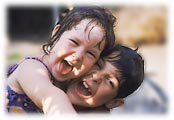
Basic
rules and Characteristics
For three month all toys and materials for handicrafts
(as crayons, paper, scissors, tools) are removed from the rooms of the
kindergarten. Only the furniture, blankets and pillows are remained. At
the children's request and if there is no other possibility, required
materials and tools can be used, but no toys. The kindergarten teachers
commit themselves to observing the children actively and to be present
as partners. However, they do not make any offers, do not provide any
rash solutions and do not place any substitute materials at the children's
disposal.
|
Further characteristics of the Toy-free Kindergarten are: |
|
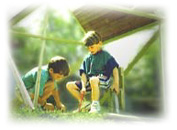 |
|
The Toy-free Kindergarten is not a Project against toys. It is not the intention of the initiators to remedy symptoms of addiction by patronising some kind of asceticism. It is an essential need for children to play, and in doing so, they take possession of the world and develop their personal skills. However, as playing is more and more influenced by finished products, predeterming the game, it might be important to provide enough space for children in order to make it possible to promote life-skills.
The Toy-free Kindergarten changes the situation in the kindergarten for a limited period of time by providing time and space for children to get to know themselves and because they are not being directed by teachers or toys, the children have to find new ways to spend their day.
Implementation, Coordination and Spreading
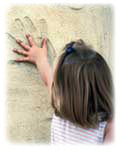 In
1992 the Toy-free Kindergarten project was carried out in a municipal
kindergarten in Penzberg for the first time. The effect of the first project
on the kindergarten children, on the educators on the daily routine was
so astonishing that the project very quickly gained tremendous attraction.
In
1992 the Toy-free Kindergarten project was carried out in a municipal
kindergarten in Penzberg for the first time. The effect of the first project
on the kindergarten children, on the educators on the daily routine was
so astonishing that the project very quickly gained tremendous attraction.
From the beginning the "Aktion Jugendschutz Bayern" was involved in the project by meetings and discussion. Because of the positive results they published a project documentation, guide-lines for those who want to start the project, an information paper for the parents and a professional video.
They also organised and carried out a lot of trainings for the professional educators and also for those who accompany the project. In Bavaria hundreds of kindergartens run meanwhile a toy free time in the kindergarten, also in other parts of Germany. A lot of them regularly every year for three months.
Other countries, like Switzerland and Austria also carried out Toy-free Kindergarten projects. In 1999 the project was presented the "Network for Mental Health Promotion for Children up to 6 years" .
This Group published a directory of almost 200 projects in the European Union. Toy-free Kindergarten is one of the 27 selected projects as particulary good examples of interventions which demonstrate documented evidence of effectiveness and which could be replicated across Europe.
Accompanying Study
In 1996 there was also carried out an accompanying study by Dr. Anna Winner. It's task was to check out if the projects that were carried out achieve the original aim to the initiators - to enhance the psychosocial competences of the kindergarten children. Twenty pedagogical staff members from different Bavaria kindergartens were questioned guideline interviews about the preparation and execution of the project, their observations of the children, their own self-reflections and their co-operation with the children's parents during this period.. The study showed that the children's psychosocial competences are enhanced in the following five fields, which are particularly important for children:
- the capability to form relations with other people,
- the perception of personal needs and self-confidence,
- communicative competence, · creativity and critical thinking,
- the toleration of frustrations and the capacity for play.
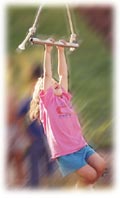 The
description of examples show how this encouragement happened: Creativity:
The
description of examples show how this encouragement happened: Creativity:
During a toy-free Kindergarten project an educator observed the following situation: A group of children tried to build a ship of waste materials as paper, wood and threads. In the middle of the boat they wanted to fix a cardboard role as mast. They had no glue and they discussed how they could fix the mast. They tried different methods without success and they became angry but they did not ask for help. The educator resisted the urge to intervene although she had an idea for a solution. She waited believing that the children will discover her technique. But what a surprise, the children invented an other method - a teamwork solution. The children were very proud and the educator too was very astonished and proud about their intelligent children. This event changed the relation between children and educator completely. A kind of partnership grew. The theoretical idea of an autonomous, powerful and intelligent child became a real experience.
Communicative competence Without exception the educators related that the children had begun to talk together more and more during the project. Even foreign children who were not fluent in German and also quiet children communicated uninhibitedly.
Self-confidence During the project a boy was quietly sitting on die floor for a long time. The educator observed the situation and she could not discover any sin in the boy's immobility. She went to him and asked him: "Is anything wrong with you?" The boy looked confused and said: "Ilka, I am thinking."
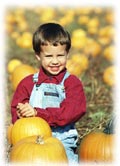 This
changing in behaviour and relationship is achieved by two interdependent
measures: Firstly, by a vacuum artificially created by the missing toys
and secondly, by the reserved behaviour of the kindergarten teachers who,
at the same time, observe the children with interest.
This
changing in behaviour and relationship is achieved by two interdependent
measures: Firstly, by a vacuum artificially created by the missing toys
and secondly, by the reserved behaviour of the kindergarten teachers who,
at the same time, observe the children with interest.Why has the removing of toys such an unexpected and surprising effect on the behaviour of children? The commercial toys seem to be no longer tools for a joint playing under children. The toys determined the activity of the children and occupied the complete attention of the children. The possession of the toy became more important than the game. The children were often quarrelling about toys.
The lack of toys provided time, space and liberty to make new experiences. The children perceived each other in a new way. They quarrelled less and co-operated more. The playing groups grew, younger children, boys and girls mixed in the games. The children learned to express their personal needs and to say" yes" or" no". The dynamic processes in the children group changed completely. The children spoke about their problems and needs, they discovered individual strong and weak points and learned to appreciate both.
Following further factors influenced the success of the project:
- The development of the first days and weeks
- The attitude of the educators
- The attitude of the parents
- Supervision and expert support
- Frequency and length of time of the project